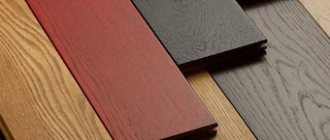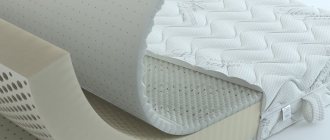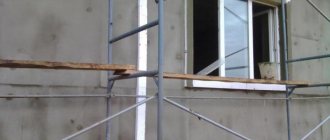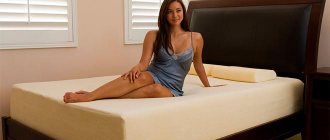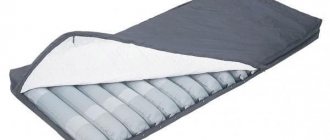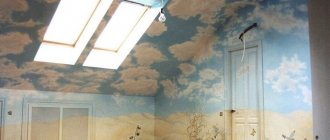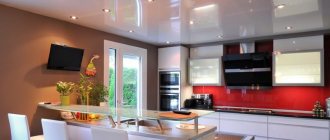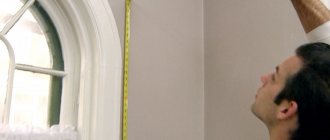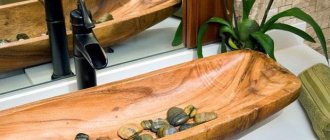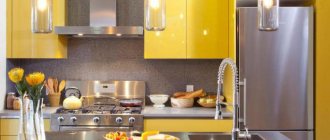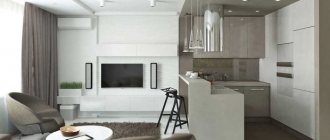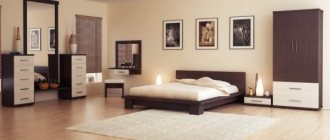DF brand products - composition, types, sizes and areas of application
The basis of decorative plywood is inexpensive peel-cut veneer (coniferous and birch). Just as in the case of ordinary plywood, several layers of veneer are glued together and then pressed using special equipment.
Cladding wood-laminated boards of various shades
The outer layer of DF, as a rule, is made from noble tree species: alder, linden, oak, beech, cherry and even exotic Afrormsia (however, the price for such material is quite high). A cheaper option for the front layer is decorative paper impregnated with special resins, or colored polymer film.
Varieties of decorative plywood
From GOST 14614-79 it follows that decorative wood-laminated boards are divided into groups according to the following factors:
- By the number of coated sides:
- one-sided;
- two-sided.
Instructions about what defects should not be on the front side of the DF
Continuation of the previous table
- According to facing material:
- DF-1 – plywood sheets covered with a transparent polymer film, through which the natural texture of the veneer remains visible. The protective and decorative layer is fixed with urea-melamine-formaldehyde resins;
- DF-2 – plywood, lined with paper or film, completely hiding the natural pattern of the veneer and imitating the texture of noble wood. To fix the facing layer, again, urea-melamine-formaldehyde resins are used;
- DF-3 - here a transparent film with increased moisture resistance, glued to the base with melamine-formaldehyde resins, acts as a decorative layer;
- DF-4 – sheets of plywood covered with a transparent film of increased moisture resistance + paper that hides the veneer and imitates the texture of valuable wood. The adhesive composition is melamine-formaldehyde resins.
In addition to the main varieties of this material, I would like to talk about two more interesting modifications:
- Flexible plywood (thickness - from 4 to 15 mm, maximum bending radius - from 5 to 15 cm). Very cost-effective and convenient sheets for making bent rounded structures with your own hands: arches, columns, furniture facades, doors, semicircular walls and much more. This plywood decor allows you to create truly exclusive interiors!
Flexible wood laminate
Flexible plywood sheets have a three-layer structure: a base layer of especially durable mahogany wood and two layers of peeled veneer. All elements are hot glued together using thermosetting plastic glue.
The photo shows an exclusive rack, the trunk and shelves of which are made of flexible plywood
- Ultralight plywood. This modification is made from tropical woods, which have a fairly low specific gravity. Ceiba veneer is most often used as the base (inner layers), and falcatta veneer and other light tropical woods are used for the outer cladding.
Ceiba tree
Standard sizes of facing plywood
Since the type of plywood under consideration is used exclusively indoors, there is no need to produce large-format DF sheets. As you can see in the table below, the largest standard parameters for decorative plywood sheets are 2440x1525 mm.
Standard sizes DF
Areas of application
Where is it acceptable to use decorative plywood?
As a rule, this material is used in various indoor construction works:
Covering surfaces - walls, ceilings, floors. If ordinary plywood has an unpresentable appearance and is therefore suitable only for rough work, then decorative sheets are a worthy alternative to natural wood panels.
Stunning plywood ceiling - mesmerizing!
Interior decoration of train cars, ship cabins, passenger transport interiors. Such qualities of DF as high wear resistance, resistance to mechanical damage and durability make it an exceptional material in this area.
Interior decoration of transport
- Manufacturing furniture from plywood - in particular kitchen facades, doors, countertops, counters and so on.
- Creation of all kinds of interior decor.
This is such an unusual Christmas tree
Plywood for furniture. Types and grades of plywood. Materials Science.
Indexed html links, end-to-end placement, prominent places in the top.
| [td] Wooden kitchen is a very vague concept. The materials for it include both expensive solid wood glued together from natural wood beams and budget slabs pressed from sawdust and various binding resins (including formaldehyde). But if you’re going to make a kitchen with your own hands, you should choose the golden mean – plywood. It is quite affordable, easy to process and more environmentally friendly compared to the same chipboard What does a furniture maker need to know about plywood? Plywood is a kind of “pie” made from thin sections (from 0.1 to 1.18 mm) of solid wood - veneer. There is always an odd number of layers, and they are laid perpendicular to the direction of the wood fibers. The sections are joined using high-pressure adhesive, resulting in a durable, wear-resistant material. Composition - for the manufacture of plywood, veneer is used from coniferous (pine, spruce, fir, larch, cedar) or deciduous (most often birch, linden, oak) tree species. Based on the number of layers, it is divided into three-, five- and multi-layer. |
Tips for processing plywood
Giving the necessary shapes to plywood sheets
In order for your plywood furniture for the veranda, hall or kitchen to turn out beautiful and even, you must follow certain rules for processing the material. They are quite simple and do not require any special processing tools.
So one of the most important processing elements is the cutting process. Glued veneer is cut depending on its thickness up to 1.5 mm using a knife. If the thickness is up to 6 mm, cutting is performed using a jigsaw; for larger thicknesses, a circular saw is used. Carry out cutting as shown in the photo
The instructions advise cutting sheets of laminated veneer plywood only along the grain, otherwise the veneer may delaminate during the sawing process. If you need to make a cut across the grain, you must first make weakening cuts along the cut line. This can be done with a regular mechanic's knife. Laser cutting of plywood is also a worthy alternative to a knife.
The process of bending laminated veneer, although quite simple, will require a lot of time and perseverance. To do this, the sheets of building material should be wetted. It should be wetted sufficiently and after soaking the building material with water, begin bending. Having bent it to the required or intermediate parameters, it should be fixed and allowed to dry for at least 12 hours. And although the process is quite long, it is worth it, because kitchen or toy furniture made from bent plywood looks very original.
Fastening plywood sheets
Fastening plywood with nails or screws is possible only after pre-drilling them. The holes must match the size of the connecting element. If your building material is made of soft wood, then a soft gasket should be placed on the screws or nails. It will protect the plywood sheet from pressing and cracking. It is optimal to use this type of fastening no closer than 12–15 mm from the edge of the sheet.
Fastening is carried out only after preliminary drilling
The process of gluing plywood requires its pre-treatment. So you should sand the surface; for this it is better to use abrasive paper No. 80 - 100. Then sweep away the resulting dust and apply adhesive to both surfaces. We compress the surfaces to be glued and leave them under load until the glue dries completely.
Description and benefits
- A collapsible model that is not only easy to assemble, but can also open up additional interest in modeling classes.
- The table frame is made entirely of natural birch plywood.
- The thickness of the supporting part of the frame is 30 mm, which guarantees stability and reliability.
- The tabletop has an ergonomic shape that allows you to use the entire surface, and the corners are comfortably rounded.
- The tabletop is made of tempered glass 8 mm thick; this technology allows you to protect the tabletop from damage from impacts or falling cutlery.
- The table top is processed according to the Euroedge standard, it is pleasant to the touch, safe and has a beautiful appearance.
- All materials used are exclusively natural, even acrylic varnish is water-based and does not contain any solvents.
- The table has adjustable legs at the bottom, which allow you to set the table level even on uneven surfaces and protect the floor from scratches.
The Barsky Status 01 Glass table can be a wonderful gift because it has a bright design, individuality and style, the “trick” in the assembly adds intrigue to it as a gift that the owner can assemble himself and then tell everyone that this is an original work.
Rules of care
Color laminated plywood is a popular material for outdoor furniture or home furnishings. A prerequisite for its long service life is proper care.
Optimal maintenance of structures consists of:
- It is best to regularly wipe dust off products;
- various liquids or dirt are removed quickly;
- it is not allowed for them to be constantly exposed to sunlight, so if items are intended for outdoor use, it is advisable to install them under a canopy;
- laminated furniture plywood should not be exposed to constant high humidity, as water causes the material to swell and lose its shape;
- It is not advisable to use any abrasive products for cleaning;
- It is not recommended to use hard brushes.
Thus, plywood is provided with the usual care, since it is also used for various wooden furniture.
Kinds
This material can be used to make a really large number of different items. These include:
- Country furniture made of plywood is considered the most common and frequently purchased. It can be represented by various sun loungers, chairs, tables and other similar structures that ensure the comfort of using a summer cottage for complete relaxation. An important point in purchasing or creating such products is their proper treatment with special protective agents that prevent possible rotting under the influence of high humidity. It is advisable to store such furniture structures indoors during winter and rainy periods. Many items are made from plywood for the dacha, so it is possible to choose a complete set in which all the parts will fit perfectly together;
- kitchen furniture made of laminated plywood - usually facades or full-fledged sets, dining tables or even bar counters are made from the material. Although there is always high humidity in the kitchen, if you choose really high-quality furniture and treat it with special protective agents, it will last for a long time, maintaining its unsurpassed attractiveness;
- transformable furniture - it is usually purchased for the bedroom or living room, and can also be used in the country. Its main advantages include the fact that it performs several functions simultaneously, therefore it is considered multifunctional and convenient for constant use.
For the dacha
Furniture transformer
For kitchen
Some items are created not only from plywood. This includes wicker furniture, the frame of which is formed using plywood sheets. Additionally, other materials can be combined to create unusual furniture.
The most popular plywood kitchen furniture made using this material is:
- kitchen sets, often combining several different materials, but the most popular is the use of plastic and wood;
- a variety of bedside tables and chests of drawers with good spaciousness;
- stools and chairs, reinforced with various additional elements, therefore can withstand even significant loads;
- children's sets, and photos of such full-fledged structures are below, and they can be used for sleeping, studying or playing;
- numerous shelves with original shapes and various sizes;
- rocking chairs that combine plywood with wicker construction.
There are numerous types of plywood, so if you plan to create interior items yourself, then before making furniture, you should wisely choose a material that has high strength and other necessary parameters.
Plywood selection
Differences in adhesive mixtures used for gluing
Plywood furniture
To make furniture products from plywood, it is very important to choose the right material. Plywood is produced by gluing veneer sheets, usually the number of sheets glued is odd - 3, 5, 7
But the material receives its main properties depending on the glue used.
- FC - in this type, plywood is glued together with urea glue. It is also called moisture resistant, but its properties are not the best and we recommend using it only when making furniture products in dry rooms.
- FSF - this type is called plywood with increased moisture resistance. In its manufacture, phenolic resins are used, which act as an adhesive. Homemade plywood furniture of this type can be used in damp rooms and even outdoors.
- FOF – laminated plywood. For its production, building material of the FSF type is usually used, which is covered with a laminating film. This building material has a wider range of colors, but its properties are practically indistinguishable from the FSF type.
Plywood thickness can be from 3 mm to 40 mm
- BV - this type is made by gluing veneer with water-soluble bakelite glue. When moisture gets on this material, plywood delaminates, so it is not suitable for making furniture products. But it has a fairly high density, about 1200 kg/m3.
- FBA - for this type, albumin casein glue is used, which, unfortunately, has extremely low moisture-resistant properties, so the use of this building material for the manufacture of furniture is very limited.
- FB, BS, FBS - for the manufacture of these types of laminated veneer, bakelite glue or varnish is used. The properties of these types are almost the same and differ in the same high density as that of the BV type, but their main advantage is moisture resistance. It is thanks to this property that such building materials are actively used in shipbuilding.
Differences in surface structure
Based on the quality of surface grinding and the number of knots, according to GOST 1996, five main types are distinguished.
- Grade E – elite plywood. For this type of building material, the presence of knots and cracks is not allowed. Ideal for the front side of furniture products, but the price of such plywood is higher.
- Grade 1 – allows cracks no more than 2 cm. Well suited for subsequent lamination and painting. It is used both for the front side and for the interior decoration of products.
- Grade 2 - allows defects up to 20 cm, glue leakage up to 2% of the total area is possible. Making furniture from plywood with your own hands from such a building material is not the best option; in extreme cases, it can be used in areas hidden from view.
Plywood grades except grade E
- Grade 3 – allows cracks and other defects up to 30 cm; glue leakage up to 5% of the total density is also possible. It is better not to use such plywood in the manufacture of furniture products.
- Grade 4 is the lowest quality building material; it may have defects of up to 60 cm or more. This type includes everything that did not reach grade 3. Such building material cannot be used for the manufacture of furniture products.
Advantages and disadvantages
Let's first decide whether to opt for plywood.
Requirements
Are there any special requirements for children's furniture? Without a doubt.
- Environmentally friendly material. Of course, it is welcome not only in the children's room; however, the absence of toxic materials is especially important here. The child actively explores the world around him. Including with the help of taste buds.
- Strength. Any experienced parent will confirm: to regard a young child as a weak, helpless creature, unable to cause serious harm to furniture, will be the height of naivety.
- Safety from injury. This point means, first of all, the absence of sharp corners and protrusions.
Important: for any wooden products, the absence of splinters is also important. Including when an object is destroyed. Children's curiosity is extremely destructive.
Advantages
To what extent does plywood meet the listed requirements? In general, why is it good for our purposes?
- The surface of plywood is the most environmentally friendly material - natural wood.
- The strength of plywood is beyond praise. Even the insatiable curiosity of a hyperactive child cannot cause serious harm to plywood furniture.
- Safety is entirely determined by the quality of the processing of the edges and surfaces of the parts. Let's put it this way: it is quite possible to make plywood completely safe in terms of injuries.
- Processing the parts and connecting them does not pose any problems. For independent production of products of moderate complexity, a simple set of tools is enough: a hacksaw, a file, a drill and a screwdriver.
Clarification: however, a screwdriver, sander and jigsaw will save you a lot of time and effort. Sawing a thick sheet by hand is extremely tedious.
Flaws
In essence, the material has only one serious drawback. Price. A sheet of high-quality plywood 15-18 millimeters thick when purchased at retail will cost 1200-1500 rubles; at the same time, a plastic children's chair or table can often be bought three times cheaper.
Alas, in this section there are no drawings for do-it-yourself plywood children's furniture. We will just try to figure out what should be followed at different stages of work - from choosing the material to applying the final coating.
Material selection
As we remember, environmental friendliness in our case is at the forefront. This is why FSF plywood is immediately discarded: when gluing the layers, phenol-formaldehyde resins are used, which retain volatility for a long time.
Our choice is FC birch plywood, despite its slightly worse moisture resistance. In addition to the use of safe urea resins, it is also good for the absence of splinters characteristic of birch. Larch veneer is much worse in this regard.
The optimal sheet thickness is 15-18 millimeters. In this case, the furniture can be frameless: instead of corners or a bar, you can use a simple butt connection of parts.
It’s a sin not to use the magnificent appearance of wood texture: instead of painting, it is better to coat plywood products with clear varnish. First grade plywood is free of knots and other defects in the outer layers of veneer; This is where our choice will stop.
A nuance: often it is simply difficult to find high-quality first-grade plywood on sale. The use of sheets of 3-4 grades is also possible; however, the time spent on painting and puttying the surface will increase many times over.
What other materials might be needed?
- Screws. For our purposes, ordinary wood screws with a diameter of 3.5 - 4 mm and a length of 50-75 mm are suitable.
- Silicone sealant or liquid nails. The use of glue is not necessary, but it is advisable: it will make the joints stronger and eliminate cracks.
- Varnish. The optimal choice is polyurethane parquet. It is extremely wear-resistant and, unlike yachts, is intended specifically for use in residential premises.
- When using a jigsaw, a wide blade will give the straightest cutting line; the narrower it is, the smaller the possible turning radius. The larger the teeth, the faster the plywood will be sawn; however, if the cut is made across the direction of the grain of the top layer of veneer, the large teeth will pick up the chips.
Manufacturing of parts
If only one side of the part is visible, it is enough to saw it with the back side up; If the condition of both surfaces is important, it is better to use a file with fine teeth.
- When cutting curved lines, you willy-nilly have to make a cut, controlling the position of the canvas itself relative to the contour of the part; but when making straight cuts, it is better to guide the jigsaw, aligning it with the line on its platform. In this case, the cut will be almost perfect (find out also).
Another useful device is a low-power laser that allows you to control the cutting line.
- To bend a plywood piece of small thickness, you need to steam it and dry it, fixing it on a template. But with a thickness of 15 millimeters or more, steaming is combined with cuts on the inside of the bend. A sheet of veneer glued from the inside onto the completely dried part will give additional strength to the part bent in this way.
An alternative way to produce parts with a small bending radius and large thickness is to glue together several sheets of thin plywood into a single unit and then dry it on a template.
Steaming time depends on the thickness of the plywood and ranges from an hour to a day; Instead of steam, you can simply immerse the future bend in boiling water. The part is fixed on the template until completely dry.
Decoration
The nursery leaves its mark on the appearance of the furniture: it is often decorated with complex patterns or designs. How can you apply them?
- The outline of the image is transferred to the details using ordinary carbon paper. The source of the image can be a children's book or magazine; If you need to enlarge the image, just use a copier with a picture scaling function.
- A wood burning device will help make the outline clear and prominent. An alternative method is to deepen the lines with a sharp chisel. If you do not have specialized wood cutters at your disposal, the work, albeit without much convenience, can be done with a stationery knife.
- The simplest way to decorate the veneer surface while leaving the texture visible is to use stain of different shades or diluted in different concentrations.
- If you want to apply a colored image to the surface of the plywood, its elements are painted with alkyd enamel. If you are planning a varnish coating, you can use watercolor or gouache.
Finishing
For first grade plywood it comes down to only rounding the edges and corners. It is for children's furniture that it is advisable to adhere to rounded lines without pronounced corners. As you might guess, the instructions are primarily related to safety.
Corners and edges are traditionally treated with a flat rasp followed by sanding with fine-grit sandpaper.
If for some reason the furniture is made from low-grade plywood, processing begins with filling the defects with acrylic wood putty. Potholes are puttyed at least twice: the putty shrinks slightly when drying.
Then the entire surface of the plywood is sanded with sandpaper: first coarse-grained, then fine-grained. In the absence of a sander, a block with flat edges wrapped in sandpaper is used to grind flat parts.
A clean, defect-free surface, as already mentioned, is varnished. It is recommended to apply parquet varnish in at least two layers; In practice, it is better to varnish the product three times. Flat parts are varnished in a horizontal position: in this case, there will be no drips on the surface.
Tip: you can simply fill a tabletop or other flat surface with a continuous layer of varnish 0.5-1 millimeter thick. To do this, the ends of the part are covered with masking tape, creating a low border.
Low-grade plywood is painted three times with alkyd enamel PF-115 or its imported analogues. To paint the first, primer layer, the enamel is diluted with a solvent.
Connections
How to connect finished parts? As already mentioned, thick plywood does not need frames or angles for joining. The connection can be made with screws or dowels.
For most cases, wood screws are suitable. The order of operations is as follows:
- Future holes are marked and drilled according to the outer diameter of the screws. Then they are countersunk with a larger diameter drill.
- The parts are combined, after which the holes are marked at the end of the second part using a drill of a smaller diameter (for the 50*3.5 self-tapping screw, the author used a 2-mm one).
- The holes in the end are drilled for the entire length of the part of the screw that will fit into it.
- The end is coated with silicone sealant, after which the parts are connected and tightened with screws.
Tip: additional insurance against plywood splitting can be a clamp, a compressive part into the end of which you plan to screw a screw.
An important advantage of self-tapping screws is that the connection can support the load immediately after assembly. However, in some cases, caps remaining visible are undesirable. A typical example is a table or children's chair made of plywood: the seat and tabletop look better smooth.
The solution is to assemble the joint on wooden dowels. The dowel is cut out of wood (preferably hardwood) and inserted with glue into pre-drilled recesses in both parts. The diameter of the dowel itself and the recesses must be such that they fit together with noticeable force.
In this case, you need a reliable and rigid adhesive connection, so you should not use silicone sealant for gluing. The parts are glued together with polyvinyl acetate or epoxy glue.
When creating unloaded structures from a material of small thickness, the rules are different. You can assemble such a children's plywood house with your own hands using blocks and 20 mm nails.
Postforming table top: a classic of the genre in the right size
You only need a very small piece of furniture countertop to save a lot on the purchase of a dining table for the kitchen. We will talk about how to make a table from a tabletop with your own hands. A classic kitchen table (photo 3) is practically no different from furniture purchased in a furniture showroom - except perhaps in the size of the table top, ideal for your kitchen.
We will need the following materials and tools:
Marking. In accordance with the drawing, parts A and B are absolutely identical in contour, the only difference is in the depth of the assembly grooves. Therefore, it is better to make one template (from whatman paper), and then use it to make markings on plywood
Pay attention to the red highlight: the stops of the grooves should be on the same line, and their width (as well as the height of the puzzle protrusions at the top of the parts) should be equal to the thickness of the plywood. Sawing and processing of parts
Attention and precision are important here: the strength and stability of the product depend on them. Sanding, tinting and varnishing must be carried out on all parts of the parts, including the ends. Assembly. If the previous steps are carried out well, assembly will not take much time: we connect parts A and B (into the groove), and we put part B on top of the puzzle ledges. If the fastening elements of the underframe protrude somewhat above the plane of the tabletop, they need to be leveled (with a grinder). We cover the parts with a final layer of varnish - the table is ready!
How good is plywood as a material for children's furniture? Are there any subtleties in processing the material in this case? In this article we will try to study the problem from different angles; In addition, you will find some useful tips and ideas in it.
The scope of application of the material in the nursery is not limited to chairs and beds. The photo shows a children's playhouse made of plywood.
DIY plywood table: possibilities and limitations
Plywood is a soft and pliable material. While not distinguished by any special strength characteristics or durability, multilayer plywood may well become the raw material for the manufacture of tables that do not experience heavy loads (both folding and folding). In some cases, even children's tables are made from it: plywood in this case can be used as a surface for various children's crafts.
The undoubted advantage of a plywood table will be its originality, as can be seen in the photo. And a homemade one, for example, can be decorated with carved shelves, also made with your own hands from plywood.
In order to ensure satisfactory strength of the tabletop, it is better to use sheet material for its manufacture. A table made from a sheet of plywood turns out to be stronger than the same one, but made from scraps of this material, even if carefully joined together using wood glue that is resistant to water and moisture. In many cases, the finished product is subsequently coated with varnish or stain. The exception is kitchens, where food is often cut.
Materials and tools required for manufacturing
The best quality plywood Sh2 (sanded on both surfaces) is considered to be the best for this kind of crafts. In this case, there are practically no surface defects in the material. Depending on the purpose, the water resistance class of the material is also selected:
- FSF plywood is suitable for products located both outdoors and indoors, so you can use it to make a folding table for a summer house or for playing table tennis.
- FC plywood is suitable for indoor use only - therefore, it is quite possible to make a desk or computer desk from it with your own hands.
Based on the wood material, it is most advisable to choose birch plywood for making a table, which is easy and easy to process and also has sufficient strength. The thickness of the material must be at least 20 mm.
You will also need:
- A template with the help of which the contours of the legs and tabletop are transferred from the drawing to the plywood sheet (for small tables, for example, coffee tables, two wide and stable legs are usually provided). A sheet of drawing paper or cardboard is often used as a template.
- Portable sander for surface finishing of countertops.
- Jigsaw.
- Electric drill for drilling technological and mounting holes.
- Hacksaw with fine saw blade teeth.
- Fasteners (screws, self-tapping screws or bolts with anti-corrosion coating).
Manufacturing sequence
The quality of the finished product largely depends on the correctness and accuracy of the completed template, made according to the product drawing. In the case of using plywood scraps connected to each other during the manufacturing process of the table, all subsequent operations are performed only after the semi-finished product is completely ready. In this case, excess glue should be removed immediately so that it does not spoil the appearance of the finished product. Since a jigsaw is used to cut out individual elements of the future table, its capabilities should be correlated with the dimensions of the parts being cut.
You will have to work especially hard on the tabletop: it should have a perfectly symmetrical appearance with allowances for subsequent sanding and removal of sharp corners. In particular, after grinding, there should be no burrs, tears or other surface defects on the surface of the tabletop. If in the future the surface is intended to be decorated, then it is better to use not paints, but colorless waterproof varnishes, under which the beautiful texture of the original material will be clearly visible.
If the table is located in unfavorable external conditions (for example, it may be exposed to aggressive chemical environments), then the best option would be to make the table from laminated plywood - in this case, the surface layer of the original material will have higher operational resistance. For example, it makes sense to make homemade kitchen tables from laminated plywood, and in some cases even writing and computer tables.
Drawings of plywood tables in various types and designs can be seen in the photo. You can look at a photo of tables made of plywood, as well as a corresponding training video that shows the sequence and order of making a plywood table.
Basic rules for working with material
To ensure that the plywood furniture you make is not only beautiful, but also durable, you should remember several important recommendations for the work process:
| Correct cutting | For work, it is best to use, with its help you can make high-quality cuts, and they can be either straight or curved (in this case, special blades are used). The smaller the tooth on the hacksaw blade, the higher the cutting quality and the less burrs and other defects are formed, this should also not be forgotten |
| Secure fastening | We recommend using only special wood screws when working, which ensure high reliability of fixation. To avoid cracking of the material, it is necessary to pre-drill holes with a diameter 2 mm smaller than the size of the screws, this will simplify the work process and prevent damage to the plywood during assembly |
| High-quality gluing | To ensure additional reliability, elements can be glued together; for this, high-quality wood glue should be used. The work is carried out as follows: the elements to be joined are ground to obtain a perfectly flat surface, after which you need to clean the surface from dust and apply glue to it. The parts are tightly pressed together and left in this position until the composition dries completely. |
| Correct bending | If you need to bend certain elements (for example, for the backs of chairs), you must first moisten the surfaces generously with water, then bend the parts and fix them in this position for at least 12 hours |
Advice! If in some areas the upper part of the veneer has peeled off, then you need to lubricate the surfaces with wood glue, and then press the area tightly through a paper spacer.
What is the difference between chipboard, MDF, plywood, furniture board, lumber, veneer?
A little discussion about furniture materials: chipboard, MDF, plywood, furniture board, lumber, veneer.
Choosing furniture materials can seem daunting. And yet, if you understand the essence of the issue, the choice will always be elementary. About this video. Watch, ask questions, comment...
Today I want to answer this question: What is the difference between the materials used to make furniture? Today, the following materials exist: chipboard, MDF, plywood, furniture board, lumber, veneer. Let's talk specifically about each of them.
Chipboard
is a shortened abbreviation of the full name: particle board.
A modern composite material obtained by pressing wood particles (sawdust and shavings), formaldehyde resins are used as a binder. Interesting fact from Wikipedia: “Chipboards appeared in the 1940s in the USA (
eng.
Chipboard) for temporary furniture of American refugees.”
An appropriate explanation that once again reminds us why and for whom chipboard furniture was originally invented.
Let us next consider the operational characteristics of chipboard. One (and probably its only positive characteristic) is stability. Products made from chipboard retain their shape, color and size under normal room conditions. This is a dead material and, in comparison with wooden furniture, does not require maintaining relative air humidity, unless you completely fill it with water.
The next indicator that directly affects the life expectancy of furniture is strength. Anyone who has had furniture made of chipboard (most likely each of us) knows how fragile this material is. Despite the external solidity, which is created by a thin layer of plastic (laminated chipboard), inside it consists of sawdust and shavings. And chipboards may differ in their density, which is immediately visible on the cut. Loose chipboard will not last you even a year: hinges will immediately fly out of it, shelves may break due to the weight of books, chips may appear, etc. Such furniture cannot be repaired, don’t even hope! If you are lucky and have purchased furniture made from higher quality dense chipboard, it will last you a maximum of 10 years. But only under the condition of proper use: do not hit corners, do not scratch and do not pour water on it. If you want to disassemble and reassemble such furniture, keep in mind that the third time you will not be able to screw in the screws.
But these are only the visible disadvantages of chipboard furniture. An important environmental indicator is that it has a hidden but targeted effect on the health of consumers. The cause of this is the binding resins, which emit formaldehyde, which is harmful to humans. The maximum permissible emission of harmful substances is determined by sanitary standards. But do all manufacturers comply with these requirements? Low-grade cheap slabs sometimes exceed the maximum permissible concentration by up to 40 times. Slabs of this class are no longer produced abroad (in Europe and the USA), and only ultra-safe “Super E” class slabs are allowed to be used for furniture production. New furniture, from which active formaldehyde particles have not yet evaporated, is especially dangerous to health.
Therefore, when purchasing, you should especially pay attention to the tape on all ends of the furniture, even those invisible from the outside. Use your sense of smell and sniff
Furniture made from chipboard with a high concentration of formaldehyde has a pungent, unpleasant odor. But often, what stands as a sample is not always what will be delivered to your home.
What is the difference between MDF
(Medium Density Fiberboard)
and chipboard? It is classified as a less toxic material, since the slabs are formed by dry pressing of fine wood chips at high pressure and temperature. Urea resins modified with melamine are used as a binder. This ensures very low formaldehyde emissions, comparable to those of natural wood. Therefore, it is considered a more environmentally friendly material and is widely used in furniture production. The strength of MDF exceeds chipboard by about 2 times, slightly increasing the service life of furniture. Unlike chipboards, MDF is a moisture-resistant material, especially if it is coated with varnish and enamel. It is practical to use such furniture in a bathroom where there is constantly high humidity.
Children's product made from chipboard and MDF
Finances do not always allow you to purchase what you want, and in this case, natural wood material seems like an expensive pleasure. There is an alternative to wood - chipboard and MDF.
Chipboard is a budget material that emits toxic components. When purchasing, ask what type of wood it was made from. For children's rooms, products made from chipboard that have group E are suitable. In high-quality options, the board must be processed on all sides: on the inside and outside it has a laminated base or veneer.
Furniture made from MDF is considered a more environmentally friendly option, since formaldehyde resins are not used to create the board. MDF holds bolts better than chipboard. You can once again disassemble and reassemble the cabinets and bedside tables. Such products have a long service life. But the price is at the level of the cost of wood. But if you decide to purchase a product made from chipboard, then choose group E1.
When buying a product made of plywood or natural hardboard, you need to know that it is environmentally friendly, reliable and durable. Previously, it was believed that plywood products were dull and simple. But improved technology was able to change the designers' vision. Since this material is flexible, manufacturers began to create children's furniture from plywood in various shapes.
DIY children's furniture
Distinctive features of furniture made from this material:
- The basis of this material is the most environmentally friendly material - natural wood.
- The stability of plywood is high. Even the most active child will not harm a plywood product.
- Safety is demonstrated by the high quality of processing of corners and surfaces of elements. It is possible to make the material completely safe for children.
- Processing elements with your own hands has no problems. To make a product yourself, you need to have a simple set of tools: a knife, a file, a screwdriver, a drill.
How to choose plywood for making furniture yourself
For self-production of furniture and other interior elements, plywood is most often used. This material has gained such popularity due to its functionality. Plywood does not require complex processing and is lightweight, combined with strength and flexibility. In addition, the cost of laminated wood panels is significantly lower than that of natural wood.
However, the plywood available on the market varies greatly. To get truly high-quality, reliable and beautiful furniture, you need to use the appropriate material. In addition, different types of plywood are suitable for different purposes. For example, if you are planning to make garden furniture, you will need waterproof FSF. Conventional furniture for home use is best made from 15mm thick birch plywood boards. For various types of interior structures - for example, podiums - more solid slabs will be required.
Large comfortable corner desk for work
Often, the corner parts of the room remain unused in the design of the space: it is inconvenient to place a table “close” to the wall, it is impractical to place a chair or armchair. The solution is to buy a comfortable and multifunctional light table Barsky Universal.
Characteristics
The main feature of the product is its size: the table is large enough to accommodate everything you need to work with documents and a computer at the same time. In addition, there is enough space to accommodate desktop organizers, flowers, and even a second computer monitor.
Which plywood to choose for the floor
When choosing plywood for the floor, you should pay attention to the following parameters:
brand of plywood. As already noted, for residential premises it is better to purchase FK brand plywood. Its moisture resistance indicators fully meet the operating conditions in residential premises;
plywood class (emission class). Only class E-1 is suitable for flooring;
grade of plywood for flooring. Plywood is divided into 4 grades. In this case, the sides of the sheet may have different grades. It is marked as 1/1, 1/2, 2/2, etc. Plywood of grades 3 and 4 is suitable for the subfloor. For finishing – 1st or 2nd grade;
humidity of plywood. A quality sheet is one with a moisture content of 12-15%;
number of layers of plywood. The thickness of the veneer in a sheet of plywood ranges from 1.7 to 1.9 mm. Consequently, their number determines the thickness of the sheet. The more layers a sheet has, the more durable it is. However, the thickness of plywood is selected taking into account its purpose. So for a subfloor you need plywood with a thickness of 12-18 mm, for a finishing floor 10-12 mm. When using plywood in production - at least 25 mm
Please note that if plywood is laid in two layers, then the thickness of the sheet should be divided into two;
plywood sheet size. There are format and large format plywood. The dimensions regulated by GOST 3916.1-96 and 3916.2 are given in the table;
The dimensions of plywood are more important for transportation and storage than for installation. After all, it is inconvenient to work with a large size, and any installation method involves adjusting the sheet to the required dimensions. The main thing is to number the selected sheets and not mix them up during installation. By the way, professionals advise laying the workpieces offset. Joining four corners significantly reduces surface quality;
plywood manufacturer. European or domestic manufacturers offer good quality material. But Chinese-made plywood causes complaints from users and often does not meet the stated characteristics.
Types of slabs
Existing options differ in technical parameters and production method.
Pressed plywood
This name refers to OSB panels, which are made from shavings. The products are among the most popular building materials.
The manufacturing technology of this plywood has some nuances:
- Chips of different sizes are used for layers, which ensures strength and reliability.
- Thanks to high pressure, the pressed structure acquires the required stability.
- The chips are laid in layers in different directions.
The high strength of OSB is largely due to the special weaving of the carpet from wood chips.
The material undergoes additional processing, which gives a moisture-resistant effect, but only products of grades 3 and 4 have such indicators. The last category has improved characteristics and is therefore used for outdoor work in aggressive environmental conditions.
Without serious protection, only grade 4 sheets can be used outdoors, grade 3 requires reinforced putty, and grades 1 and 2 are designed for indoor installation
Glued version
This is a fairly popular product made from veneer. Various compounds are used to connect the layers.
Currently there are the following varieties:
- FC. It is based on urea glue with phenolic additives. It has good resistance to moisture, but without direct contact, so the boards are used exclusively for interior cladding. To enhance the properties, parts can be treated at home with special primers and waterproofing mixtures.
- FSF. The veneer to produce such moisture-resistant panels is glued together using phenol-formaldehyde resin. The structure of the products is preserved even in direct contact with liquid, so the material can be used for facade work.
- FBK. It is made by impregnation with bakelite varnish. The resulting products are characterized by increased strength and are suitable for use in difficult climatic conditions.
- FBS. Also called "marine" or "Finnish" plywood. It is produced using a bakelite composition, but, unlike the previous version, alcohol-soluble glue is used. The material has excellent performance properties and includes varieties FBS-1, FBS-A and FBS-1A. The surface of the products is completely waterproof, so even direct contact with sea water is allowed.
- FBV. The peculiarity of this material is that a water-soluble bakelite composition is used to glue the veneer. The panels are quite strong, but do not have a water-repellent effect, so they are not recommended for use outdoors and in areas with constant high humidity. Includes variety FBV-1.
- FOB (FOF). This category includes decorative and laminated options. Due to the presence of cladding, the products cope well with harmful external influences.
Only bakelite plywood glued with alcohol-soluble glue has high moisture resistance parameters; FSF, although it is declared as waterproof, can only be installed in technical unheated premises, and FC sheets are not moisture resistant at all
The FBS and FBV brands can be quickly distinguished, since they look different: the first variety is brown, the second is black.
Overview of varieties
Furniture made from plywood can be used in absolutely any room of your home without much difficulty. In this case, you need to carefully select this kind of product, first of all taking into account the conditions in which you are going to use the purchased structures. So, for some rooms, cabinet furniture is ideal, which can withstand high humidity well, while for others, decorators do not recommend using laminated material.
Plywood is an excellent choice of material to create stylish office furniture. Original ideas from professional designers can become a unique decoration for any modern office. Many design studios offer customers interesting products made from high-quality plywood: durable tables, cabinets convenient for storing papers, wide shelves designed for storing documentation, creative chairs for office workers, original armchairs and couches for visitors.
Plywood sheets are often used to make very interesting-looking cribs for children, compact transformable computer tables, low cabinets, walls, luxurious dressing tables, and comfortable chairs. For safe operation, it is best that all corners of wooden furniture intended for children's rooms are rounded. In this case, the plywood sheet is coated with any desired color or its natural shades and texture are preserved, but it is still treated with a special stain or a special varnish.
Garden and country furniture made of high-quality plywood is usually represented by light tables and comfortable sun loungers, and other original designs that should provide the most comfortable rest and are characterized by increased moisture resistance. During the cold season, such furniture is brought into a warm room, so many products in this series are often collapsible for ease of storage and movement.
Prefabricated pieces of hand-made furniture will allow you to quickly turn an ordinary bedroom into an exquisite boudoir, and the living room into an original room, decorated in a loft or minimalist style.
Design chair Barsky Status 01/1 gray
Specifications
- Material: composite material of natural birch plywood
- Upholstery material: flock fabric.
- Type: chairs for home, chairs for kitchen, chairs for cafes, bars.
- The color of the wood is light.
- Upholstery color is grey.
- Net/gross weight: 5 kg/5.7 kg.
- Dimensions: 49x50x80 (h) cm.
- Seat height 42 cm.
- Warranty: 5 years.
- Manufacturer: Barsky.
- Country of origin: Ukraine.
additional characteristics
Material: multi-layer birch plywood 30 mm
Upholstery material: flock fabric, abrasion-resistant
Demountable, easy assembly
Highly ergonomic and comfortable
Natural eco-friendly materials
Natural water-soluble varnish coating
